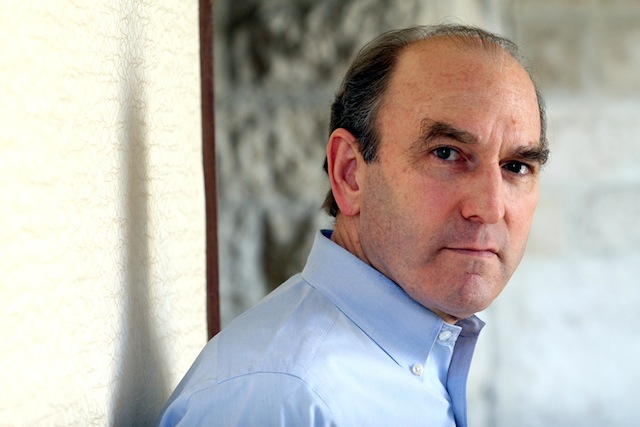by Mitchell Plitnick
The shell game is a tried-and-true method of persuading people to give their money to the person running the game. In political terms, it’s also a reliable method of persuading people to buy into the political stance of the man running the game.
Elliott Abrams is a master of the shell game. He provides what seems like a serious and sober analysis, with just enough cherry-picking of facts and omission of detail to convince you of his point of view. That is a big reason why this man, who is responsible for some of the greatest foreign policy fiascos in American history, continues to be considered a legitimate source for foreign policy analysis.
Perhaps it’s not surprising. Despite the enormous catastrophes brought on by the neoconservative school of thought of which Abrams is a part, the philosophy, such as it is, continues to be an influential voice in the foreign policy debate in the United States. This is, however, even more reason to look at an apparent change of course from Abrams with a skeptical eye.
The Reversal that Isn’t
That so-called change of course came in an article last week in Foreign Affairs where Abrams seemed to admit that settlements were indeed an obstacle to reaching a peace agreement between Israel and the Palestinians.
For Abrams, the growth of major settlement blocs where the vast majority of Israeli building in the West Bank has occurred under Prime Minister Benjamin Netanyahu’s watch is not an impediment to a negotiated solution between Israel and the Palestinians. However, he argues, growth outside those major blocs is. To some, this is a major reversal of Abrams’ long-held position on settlements.
That’s what we’re meant to think. It certainly took in Rabbi Eric Yoffie, the former head of the Union for Reform Judaism. In an op-ed in the Israeli daily, Ha’aretz, Yoffie opines that
After admitting that it is ‘remarkably difficult to discern what is going on outside the blocs,’ Abrams states that according to his most recent calculations, there were 73,000 settlers living outside the security fence in 2009 and 93,000 in 2015. If the new Netanyahu government continues to settle at this rate, there will be 115,000 settlers outside the blocs by the end of the government’s term. The implications of this growth, Abrams writes, is (sic) that it will be exceedingly difficult and costly to make a two-state solution happen under these circumstances.
Actually, this is nothing new from Abrams. Over a decade ago, he was a driving force behind the letter George W. Bush sent to then-Israeli Prime Minister Ariel Sharon, which spoke of the need to adjust the 1967 borders to accommodate “demographic realities” since that fateful year. The result was that Israel felt free to build in the so-called “major settlement blocs.”
That has become an accepted reality in Jerusalem and Washington. In Ramallah, though, not so much.
Lara Friedman, director of policy and government relations for Americans for Peace Now, and one of the leading experts on settlements, clarified the evolving debate:
The greatest threat on the ground to the two-state solution is construction in the so-called blocs. ’So-called’ because they have never been formally delineated. This has allowed them to be defined according to the ever-evolving whims of settler apologists and advocates (including Abrams), to become ever-expanding to the point where they encompass so much of the West Bank—and in key areas, especially around Jerusalem—that if we go with the “everybody knows” argument (i.e. that there is a basic understanding that Israel will keep these blocs in an eventual peace agreement) that Abrams favors, the two-state solution is already effectively dead.
Why? Because no Palestinian leader ever will sign (or should be expected to sign) an agreement that leaves Israel in control of “blocs” of the West Bank that leave behind an only nominally contiguous state. The reality on the ground is that the Maale Adumim bloc reaches to the edge of the Jordan Valley; the Etzion bloc south nearly to Hebron and East to the Jordan Valley ridge; Givat Zeev reaches the outskirts of Ramallah; the Ariel and Kedumim blocs reach more than halfway to the Jordan border; and the new “Beit El” blocs is east of Ramallah.
Friedman is quite correct. The idea that these settlements would remain in Israel’s hands was always problematic. But when Ehud Barak first broached this idea, during the Camp David II talks in 2000, those settlements were also much smaller than they are today. Every settlement or bloc also has an area around it that is much larger than the built-up settlement itself and considered that settlement’s land. That area expands outward as the settlement does.
As B’Tselem, the leading Israeli human rights group, puts it:
The radical changes Israel has made to the map of the West Bank preclude any real possibility of establishing an independent, viable Palestinian state as part of the fulfillment of the right to self-determination. The settlements have been allocated vast areas, far exceeding their built-up sections. These areas have been declared closed military zones by military orders and are off limits to Palestinians, except by special permit. In contrast, Israeli citizens, Jews from anywhere in the world and tourists may all freely enter these areas.
Two States Versus One
The situation Friedman describes is hardly unknown to Abrams. It was his idea, after all, for the United States to send Israel a message that it could build all it wants to in the major settlement blocs. His so-called “concern” over the settlements outside the major blocs is a red herring. The real problem, as Abrams well knows, is the fact that, over 15 years after the idea of two states where the bulk of the settlements would remain in Israeli hands, expansion of those blocs has made this incompatible with a Palestinian state.
That doesn’t mean that something can’t be worked out. There are many other options for a two-state solution than the stale ideas of decades ago that no longer match the realities on the ground. But let’s not kid ourselves about what we’re up against if we want to make that idea a reality. The right, and especially the neoconservative right, is not waking up to the error of its ways. On the contrary, what Abrams’ article demonstrates, if one looks beneath the sheep’s clothing he draped over it, is that those same wolves that have thwarted peace efforts until now are today mapping out the one-state future they have been driving at for decades.
Yoffie expressed the hope that if someone like Abrams could change his position, it might influence Benjamin Netanyahu. But Abrams has not changed, and there remains no reason for Netanyahu to do so either. Bibi may not be the most popular guy in foreign capitals, or even in Israel. But he just won his fourth election to be prime minister of Israel. He knows what got him there, and it wasn’t making concessions or giving a damn about the rights of Palestinians or the security that peace could bring to Israel. And Elliott Abrams will still be in his corner.






Elliott Abrams needs to comprehend that most of the illegal Jewish settlements in the occupied West Bank will become part of independent Palestine. Otherwise there will be no deal on Israel/Palestine.
As the article indicates, Abrams comprehends. The question is whether the President’s advisers and those working on the French version at the UNSC do too.
Another sop for the “progressives.” What? Elliott Abrams hasn’t changed his stripes? This commentary is just another brick in the left-most boundary wall of officially sanctioned and permissible “debate” concerning Israel. Peace, settlements, and two state solutions–those are the truly red, blood-red “red herrings,” not some self-professed traitor’s “’concern’ over the settlements outside the major blocs.” We debate the existence of the “settlements”–but not that of the mother settlement itself, “Israel.”
Old habits die hard. I see that Abrams hasn’t bothered to wipe the blood off his hands from Central America as there are some tens of thousands there who would like to settle Abrams for good. Like many sociopaths Abrams obviously knows how to survive and I’m surprised that there is no mention of the thousands of innocents who perished from policies carried out by him in C.A. That he is even involved in mideast policy doesn’t bode well for anyone involved in the area.
Took him how many years…?